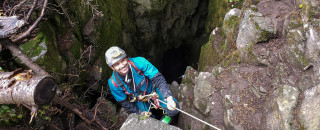Caving for Bones: How Tyler, Randy, and Kaedan Fell Into a Fossil Archive Deep Within Utah’s Caves
By Beth Mitchell
According to Tyler Faith, paleoecologist and Chief Curator at the Natural History Museum of Utah (NHMU), rappelling deep into Utah’s caves is as exciting as scaling cliffs in South Africa’s Swartberg mountain range in search of fossilized rock hyrax pee. In fact, the two aren’t unrelated—if you’re Tyler, anyway. He’s fascinated by environmental change over time; his research lies within the nexus of climate change, mammals, and people.
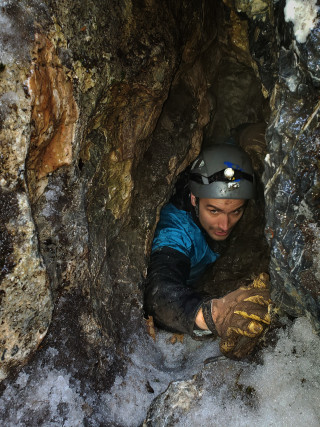
Dr. Tyler Faith, chief curator of NHMU, squeezes through the narrow opening of an undisclosed cave where a team of NHMU researchers examined animal bones discovered within. Photo by Randy Irmis
“I'm most interested in questions about the ecological drivers of human evolutionary history, and when and how we, Homo sapiens, started to change the environment.”
Tyler began his career tackling these questions through the study of fossil mammals. But more recently, he has shifted his focus to a more pungent trace of past life. Over the last several years, Tyler has been traveling to South Africa to reconstruct past climate and vegetation by analyzing the crystallized urine mounds of small mammals called rock hyraxes, which are chockfull of environmental indicators that can be radiocarbon-dated. The more urine collected, the more data to analyze and date. Link these records to archaeological and fossil evidence and we begin to tease apart how climate as well as human activities have changed the world around us—changes that are ongoing today.
Animal fossils—in urine or not—are the closest thing we have to a time machine to understand ecosystems in the past. You may have heard the term Anthropocene; it’s a proposed geological epoch defined by the start of significant human impact on Earth's geology and ecosystems. Humans have always been impacted by our climate and environment, but it’s now clearer than ever how we are impacting the ecosystems around us.
That brings us to 2018, when an opportunity to record the consequences of climate change appeared in Faith’s inbox without fanfare, offering scientists at NHMU a unique collaboration both closer to home and to the present day. Eric Richards, a local Utah caver and one of the coauthors of new research just published in the Journal of Mammalogy emailed Dr. Randy Irmis, Curator of Paleontology at NHMU, who forwarded the email to Faith.
“I’d been doing vertical caving throughout Utah for at least a few years, and I kept finding skulls and bones—particularly at the bottom of cave entrances,” said Richards. “I’d never take anything out of a cave because I’m not a scientist and I don’t have permits, but I thought to myself, ‘I bet somebody at a museum would know what these are.’”
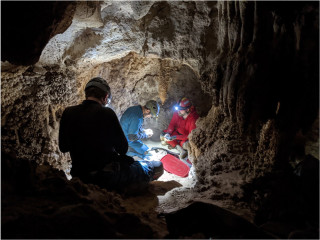
From left to right, Dr. Randall Irmis, NHMU's curator of paleontology, Dr. Tyler Faith, NHMU's chief curator, and caver Tom Evans examine and collect mammal bones on the floor of Tubafore Cave. Photo by Colin Stern
“Eric was very matter-of-fact in the email,” recalls Irmis. “I think he said something like ‘I go down into dozens of caves every year and there are a lot of bones down there. Is this of any interest to the museum?’” It was.
Both Irmis and Faith responded almost immediately, kicking off the Utah Cave Paleo project that brings together two seemingly disparate passions, paleoecology and vertical caving, in the name of scientific discovery. Right from the start, Richards offered himself as a field guide and caving trainer, help that Irmis and Faith gladly accepted.
“The Utah caving community can be insular and intimate at the same time. And caving is a weird hobby in that you don’t need to know somebody too well if they’re interested in the same thing, and serious about training and doing it,” said Richards. “I could tell Randy and Tyler were committed to doing it, and they picked it up quickly.”
After training in several local caves to learn vertical techniques, including a harrowing visit to Neffs Cave—a whopping 1150-feet deep cave not far from Salt Lake City—that ended in a near whiteout a snowstorm—Irmis and Faith had earned their stripes and were ready for Boomerang Cave in the Bear River Range in Cache County, Utah.
To support the project, Faith received funding in 2019 from the National Geographic Society and University of Utah NEXUS program, obtained a research permit from the U.S. Forest Service in 2019 to collect fossils from Boomerang for analysis at the Museum. The analysis from Boomerang Cave is the basis for the first published research from the Utah Cave Paleo project. Kaedan O’Brien, a University of Utah Ph.D. student working in Faith’s lab, meticulously identified each specimen over six months.
“We selected several specimens for radiocarbon dating to determine the age range of fossils we found in the cave,” said O’Brien. “We chose bone fragments that we couldn’t classify taxonomically to limit destructive analysis.”
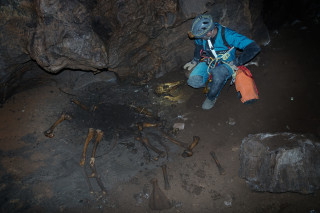
Dr. Tyler Faith, NHMU's chief curator, examines elk bones inside Skeleton Cave in the Uinta Mountains, Utah. Faith and a research team from NHMU collected bones from the site but left the elk skeleton in place given that it is the namesake of the cave.
Photo by Randy Irmis
What they found was remarkable. Fossils found in Boomerang Cave were shown to span the past 3,000 years, with the bulk from the last 1000 years or so. Comparison of these fossils to museum records and present-day mammals collected by co-authors and NHMU zoologists, Dr. Eric Rickart and Katrina Derieg, showed that the cave provided a faithful reflection of mammal diversity in the area. Perhaps most exciting is that the fossils also revealed the presence of a species unknown to the region, Merriam’s shrew (Sorex merriami). The full list of fossils is in published scientific article in Journal of Mammalogy, along with more on why this research matters.
But O’Brien’s own words may offer the most accessible proof of relevance for this work. “We know that high elevation ecosystems are one of the most susceptible to climate change. Mountains in places like Utah are going to be some of the first to experience stark changes from those shifts,” he explains.
To know how the climate is affecting animal species, we first need to know what lived there in the past.
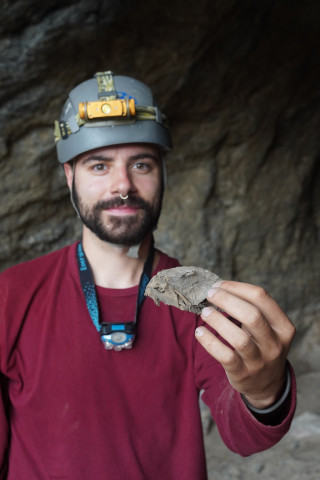
Kaedan O’Brien, lead author and anthropology Ph.D. candidate at the University of Utah, holds up a mummified wood rat at an undisclosed cave in the House Range of western Utah. Photo by Randy Irmis
And unfortunately, we don’t have a lot of records. O’Brien attests that we need specimens back hundreds of years to characterize what these ecosystems looked like before modern human impacts on climate really took hold. And the best way to do that? Cave collection.
He explains that fossils are rare in the mountains – things often fall downhill – so caves provide the most faithful record out there. “Caves are like these refrigerators,” he said. “They keep everything perfectly preserved for hundreds and thousands of years.”
Boomerang is only the beginning. The collaborative team on this paper will continue their ‘deep dive’ into the recent past. Their hope is these efforts prove useful to future scientists by providing zoological baseline observations to evaluate the environmental impacts of anthropogenic climate change in these very same ecosystems in the decades to come.
Eric Richards, a software engineer, and his wife Fumiko, also an engineer and coauthor, are all in for future cave exploration. In fact, they’re both now volunteers in the Paleontology Prep Lab at NHMU.
“This whole process has been so validating, that the things that stood out to me stood out to Randy and Tyler,” said Richards. “I love doing this stuff with them because I know it’s not just going into our caving newsletter; it’s contributing to science and our knowledge of ecosystems. I just feel lucky to be there.”
